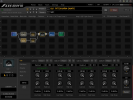I've found a few things when trying to dial in harmonies...hope these help some.
1. For harmonies (adding to direct sound) I like the pitch block better when used in parallel (rather than in series), and then put the Mix to 100% wet. THEN use the Level to bring the harmony amount up to where you want it, and also you can PAN the harmony off instead of center, which can help.
2. The high and low cut located in the pitch block are your friend. I will usually cut everything under 100Hz and maybe drop the high cut to 6000kHz or even lower, to taste. That can take out some of the really high top end "digital" artifact stuff, if present.
3. Then it's really the pitch shift algorithm you choose, try a few of them.
4. Sometimes it's about what harmony notes you want to play. Maybe you play the high harmony part, and use the pitch shifter to play the original root line melody. When I do Sweet Emotion by Aerosmith, I do it that way - the classic whammy (algorithm in this case) is set to play the lower original figure/riff, while I play up a 5th on the harmony part. So think about you playing the high harmony on guitar (rather than the algorithm), and let the pitch shift play the lower harmony as one method.
You'll get there!


